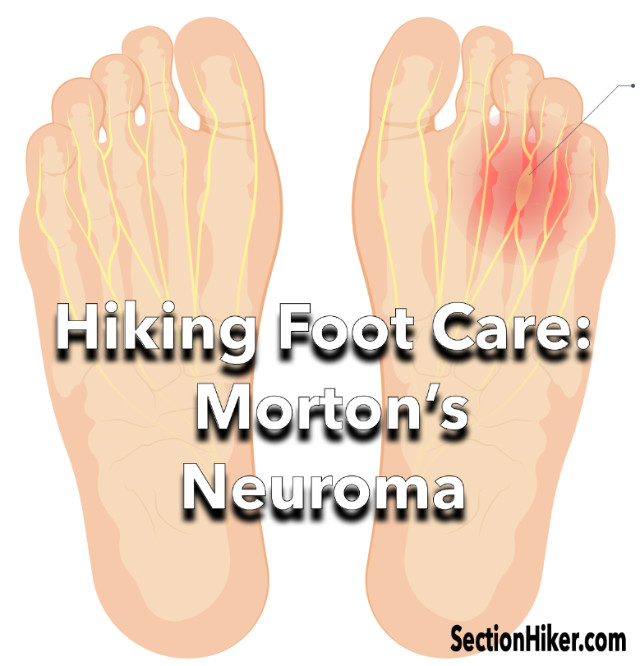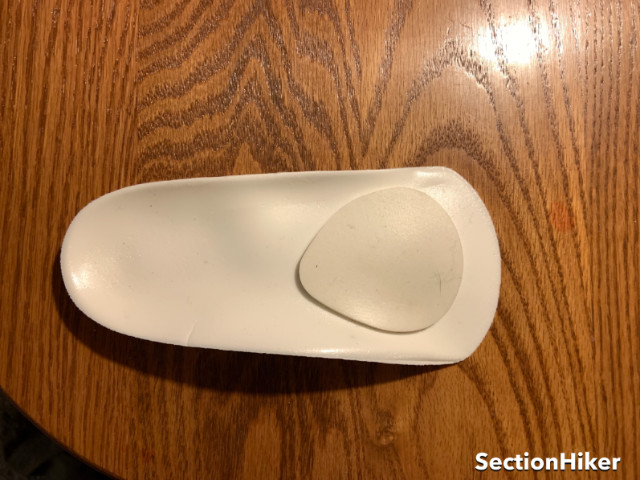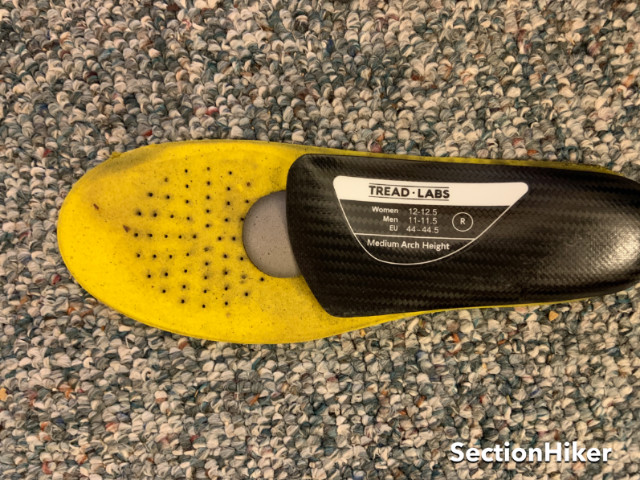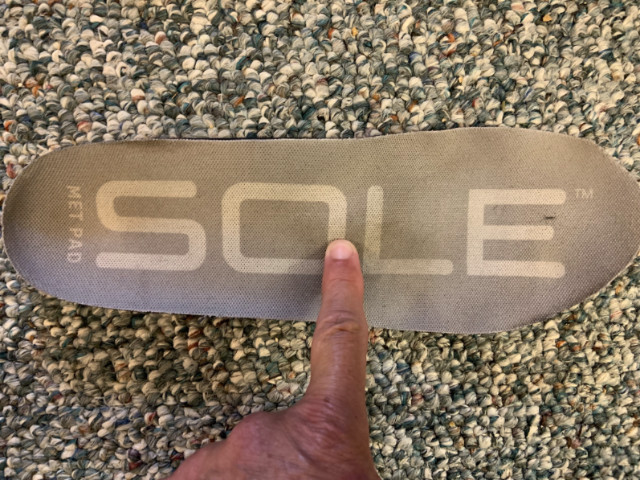
Morton’s Neuroma is an inflammation of the nerves leading to your small toes and presents itself as a burning or tingling sensation or the feeling that your sock is bunched up in the front of your shoes, even when it isn’t. Once inflamed, Morton’s Neuroma won’t away without proper care and may become painful enough to keep you from hiking. The Cleveland Clinic estimates that one in three people suffer from Morton’s Neuroma, so it’s pretty widespread, but often goes untreated because people don’t realize that they have it or where to go to seek treatment.
If you have one of the aforementioned symptoms and suspect you have Morton’s Neuroma, you can perform a simple test to check. Called Mulder’s Test, it’s used by foot doctors (podiatrists) to diagnose Morton’s Neuroma ailment. I performed this tent on myself and when I heard my foot click, I knew it was time to schedule a Podiatrist appointment.
Causes
There are a number of factors that can contribute to getting Morton’s Neuroma. It can be caused by repeated stress to the foot, wearing tight poor-fitting shoes or high heels, or inherited foot deformities. Wearing hiking shoes with a wide toe box like Altra Running Shoes can help prevent Morton’s Neuroma if you start young enough and you have good genes, but switching to them after a neuroma has formed won’t make it go away.
Treatment
In extreme cases, you can have a neuroma surgically removed, but that’s an option you probably want to avoid. But if you catch it early enough, you can reduce the inflammation with podiatrist-prescribed anti-inflammatories since over-the-counter varieties like Advil and Alleve aren’t strong enough. In more advanced cases, cortisone shots can also provide relief.
Insoles
In addition to medication, it’s important to use a shoe insole that takes the pressure off the afflicted area between the 3rd and 4th toe so you don’t keep stressing it. This is achieved by using an insole with a metatarsal pad, which your podiatrist is likely to give you. The metatarsal pad is positioned behind the ball of your foot relieving pressure on your metatarsal bones and toes when you walk.

But the problem with these podiatrist-prescribed metatarsal pads is that they are attached to the top of a foam insole with an adhesive that is quickly torn off by friction or moisture. Sourced from medical supply companies, they are intended for casual everyday use and aren’t robust enough to stand up to the rigors of serious hiking. I’ve been through this first-hand.
What you want is an insole for hiking boots, mids, hiking shoes, or trail runners that has good arch support and a metatarsal pad. It’s important that the insole’s arch can survive the impact of hiking without collapsing and that the sole won’t break down if it gets wet. In addition, you want a metatarsal pad that is fully integrated into the insole or located underneath so it isn’t dislodged by the movement of your foot inside your shoes. These requirements eliminate a lot of products

But, I’ve had good luck with two insoles that meet these criteria including:
Both of these insoles can take the punishment of hiking, they can get wet, and then dry without being affected or ruined. I use the Treadlabs insoles with met pads in my hiking trail runners and winter boots, and SOLE insoles with met pads in my cross-country ski boots and fishing boots.

The important thing to keep in mind is that these insoles will create an environment in any shoe that will give your neuroma time to “settle down” and income less inflamed. You can try many different new shoes to get the same effect, although I doubt you’ll have any success: instead, having a properly configured set of insoles and a strong anti-inflammatory prescription will be the quickest and most efficient way to reduce your discomfort.
Wrap Up
If you suspect you have Morton’s Neuroma, make a podiatrist appointment for a check-up. It really is the most expeditious way to deal with Morton’s Neuroma so you can keep on hiking without pain or discomfort. It’s hard to believe that I put up with it for as long as I did, but I really didn’t know any better at the time.
 SectionHiker.com Backpacking Gear Reviews and FAQs
SectionHiker.com Backpacking Gear Reviews and FAQs
I’ve had bunion surgery on both of my flat arthritic feet, Morton’s toe, Morton’s neuroma, and plantar fasciitis, so I’m familiar with foot problems… including those caused by chewing on them because they’re always in my mouth! Last year, foot problems took me off a section hike, which caused an “it takes a village” scramble to get me to the nearest road.
What has helped me is forking over $500 or so for custom orthotics. I still have foot issues but for the most part, the orthotics keep them somewhat manageable for me.
Was diagnosed with Neuroma a few years ago, caused by wearing a pair of leather boots with insufficient room in the toebox for my toes to flex. Very painful while on the trail. Would force me to stop periodically to stretch my toes and wait for the pain to subside. Required minor surgery in a clinic to remove the “calloused” nerve. Switched to Vasque hiking shoes with more room for my toes. Problem solved.
I have had a different experience from you. My Morton’s neuroma is pretty bad, and I have seen the podiatrist as well. The metatarsal pad that he gave me (two) are both still attached to the inserts and have never budged. In fact, I tried to remove them and was unable to. However, they also didn’t totally ease the pain. I have recently found that when I switched from hiking in my boots, to using my Altra trail running shoes, that the pain has completely gone away, hallelujah! I have been wearing them for all my hiking over the past several months, with no pain, which I used to get on every hike. I also have hiked with a friend who swears by his Keen hiking boots which have a wide toe box, and another who orders his hiking boots in a wide size.
Sorry to hear that Paula. I have a pair of Altra Lone Peaks but haven’t committed to hiking in them yet because I find them to be a little “sloppy”. I was going to try a pair of Topo’s. I’ve found that I can reduce my pain level substantially by rubbing vaseline over my toes before a hike so they don’t rub against each other.
I agree, they are a little sloppy. I do miss my hiking boots. I have worn toe socks when hiking to prevent my toes from rubbing together.
I love my Topo’s!
Hello. Which Altra trail shoes did you buy? I would love to say “Hallelujah” because my neuroma is so bad, I’ve spent too much money on hiking shoes that didn’t work for me. Thank you!
I wonder if it would be prudent to just buy these things and insert them into my hiking shoes. Maybe a spare pair. No idea of how long these will last, am prepping for my attack on the AT. At my age (72) I like to be
ahead of the game.
“these things?” you mean insoles? they last as long as a decent pair of shoes – 500 miles. they can’t hurt.
I had a neuroma which was extremely painful and no matter what I did to try to cushion where the impact was, nothing helped that much. Of course, I googled everything I could find about neuromas. One thing I discovered was a treatment called radiofrequency ablation.
It seemed to me that the only downside to this was that it wouldn’t work so I went ahead with it. I was pain-free for four months, then I began to have some pain on the top of the foot (not on the bottom) in the area where the neuroma is. I coped with this by padding the top of the boot to keep the boot from pressing on the affected area.
Fast forward to 18 months later. I am completely pain-free although I am still keeping the pressure off the top area of my foot.
Am I glad I did this, yes, yes, and yes!! Although the procedure wasn’t exactly pain-free and pleasant – on the other hand, I am extremely susceptible to pain so maybe others wouldn’t find the procedure so unpleasant.
I am now hiking and backpacking without the agonizing pain from a neuroma!!
Had to look that one up:
“Radiofrequency ablation (RFA), also called radiofrequency neurotomy is a procedure that involves heating a part of a pain-transmitting nerve with a radiofrequency needle to create a heat lesion. This resulting lesion prevents the nerve from sending pain signals to the brain. RFA treatment typically provides longer-lasting pain relief compared to other therapeutic injections.”
Didn’t you also have another major foot ailment. It’s been a while since I saw you with your shoes off. :-)
I have horrible feet for a hiker. Years ago, one foot got screwed up by bad bunion surgery and attempts to straighten out my hammer toes. This means that foot is a size and a half smaller than the other one which causes problems with boots. Plus I have high rigid arches which means there is only a small area of the foot in contact with the ground (my feet absolutely hate steep downhills!). My feet usually start to complain after about 6-7 miles.
On top of all this, I have had several bouts of really bad plantar fasciitis, a torn plantar fascia, torn ankle tendons, and an ankle broken in three places.
My feet were doing quite well (for them!) – and then I got the neuroma!
I’m really amazed that I’ve somehow managed to hike and backpack all these years! Still doing it at the ripe old age of 79 ( can you believe it?) with a hip replacement – Easier trails though and I avoid rock scrambles.
BTW got Placer Poles because of your write-up – love them!
You are a trooper! Always were. Glad those pacer poles are good for you. I can’t hike without them.
Hey Christine, I’m 79 too and have numbness in all my toes from L4 & L5 disc problems. I just put 95% of my pack weight on my hip belt. It works for me. I backpacked the Grand Canyon, North Rim to South Rim when I was 74. It was a lot easier when I was 65.
Cheer up, “The first 100 years are the hardest.” ;o)
I started going barefoot about 8 years ago at age 47 in an attempt to learn how to run without pounding. It has been a very fun adventure! I had some setbacks at first because my feet were weak from wearing shoes all my life and then from overdoing it in various ways. The first time I heard about Morton’s Neuroma was on a barefoot running forum where people were talking about how going barefoot helped them. I do wear sandals (Luna Oso flacos) when I go backpacking. I think, whether you go barefoot or not, that strengthening your feet is very under rated and can help immensely with all sorts of foot issues. Also not crushing or distorting your feet with footwear is huge. Plus it is just pure fun to run barefoot through the mud on a rainy day!
Thank you for posting another informative foot care topic.
I caught mine early this winter in the stages of “hey doc, it feels like my sock is bunched up…” I wasn’t hiking much, but I was running on the treadmill a lot during the worst of the precip in some shitty shoes as I’ve learned. I’m still experimenting with meta pads in my Hoka SG’s (wides) and Oboz Bridgers, depending on the terrain de jour, and the sensation is nearly gone after a couple months of treating my feet right. One thing the Podiatrist did mention: I should STAY OFF treadmills for the simple reason that since my feet are predisposed for the condition, the treadmill gives a false terrain reaction and my feet are trying to correct (incorrectly) to the bounce of the machine.
Probably the most important recommendation from the Dr. was that my shoes need to have a “rigid” toe box – when pushing in the nose of the shoe, it should not bend up. Which is to say, if I flex it up it goes “easy” but should resist a bit.
And yes, I threw my Lone Peaks in the Salvage Army bin last year after only 100 or so miles – on the descent, that shoe took the path of least resistance in every unsafe direction. Might have been lack of trail running experience, but was not the right shoe for me regardless of the accolades seemingly across the board for the large toe box, grip, and weight.
I’m not entirely convinced of the rigid toe box requirement, but I’m not a doctor. I think taking the pressure off the metatarsals bones to relieve the Neuroma is probably enough, but I could be proved wrong. But I suspect every case is different.
SOLE! SOLE! SOLE!
I’ve used these heat moldable insoles for the past 15 years and love them. ABSOLUTELY no more foot sole blisters.
I’ve never had Morton’s neuroma but if SOLE offers a moldable insole with the proper pad and you have Morton’s neuroma then GET IT.
Thanks for posting this! I believe I’ve had this for over 30 years and didn’t know what it was. I was told back then that it was a “nerve thing” and that I could get a cortisone shot but it would be “really painful”. Needless to say, I was deterred from getting it. I don’t wear heels very often (heeled sandals are generally better than closed toe), but noticed it a lot hiking downhill in winter. I notice it much less so when hiking in trail runners. (Boots aggravate it when my feet slide forward; the three season Hokas less so than the lined winter boots.)
Anyway, I guess I’ll be looking for a podiatrist! Especially since I now have pain on the ball of the same foot (only when barefoot).
The latter sounds like Metatarsal pain, which I suffered from at the same time. The podiatrist might give you an anti-inflammatory and a cheap foam insole that disintegrates in just a few hours. The thing that cured both conditions and is much more durable are these half insoles with metatarsal pads – available on amazon (link below). I just wear them as is. I haven’t had any pain – metatarsal or morton’s since. https://amzn.to/3YzNwC0
Thank you! I appreciate the suggestion, and will give these insoles a shot. (I did get orthotics back in 1989 or 1990…even if I could find them–which is definitely possible–they probably aren’t correct anymore.) Anyway, I’m allergic to NSAIDs, so would prefer not having to go down that road if I don’t have to do so (though, obviously will check with a doctor if this doesn’t help). Thanks again!
The insoles are excellent! I wore them inside the 400g Keen Revel for a wintery hike a couple weeks ago. Typically, my left foot would be in pain that would shoot up my leg. I kept waiting….and nothing. They held my foot/toes up in the right way and it didn’t happen! Thank you again for the recommendation!
I’m still wearing mine in all my hiking boots and shoes.
I’ve been struggling with Morton’s Nueroma for almost six months. I’ve changed my footwear and have had two Cortizone injections which wore off within a month. I love hiking and being active, but my partner can run circles around me. I hate being in pain after walking two miles. I’m scheduled for surgery November 1st, I want my life back!!!
Surgery sounds pretty drastic. Are they planning to cut your nerves?
Been a long time reader and hardcore neuroma sufferer over the last few years. I’ve got several neuromas from my backcountry ski boots. I’ve had a handful of RF ablations, most likely with at least one more in my future before I throw in the towel and chance it on surgery. Always willing to try a new footbed, though! Ordered the Tread Labs last night based on this article.
Unfortunately, I suspect hikers often fall prey to neuromas because hiking is often “type 2 fun” so some mild discomfort in the foot is just one more thing to add to the list of discomforts (wet, cold, hungry, thirsty, etc.); as a result one simply pushes through the discomfort and then forgets about it upon return to the car.
I appreciate the review! All your reviews are always thorough and well thought out. I’ve ordered multiple pieces of gear at your recommendation.
Thanks Alex. I try to keep the website useful for people (and it helps me remember what I know).